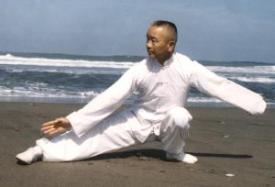
Nineteen Principles
Basic to the Practice of Tai Ji Quan
- Whole body relaxed; do not use force.
- Keep the mind concentrated; do not let it wander or become confused.
- Be peaceful and natural; do not be tense.
- You must hold the head up straight and feel as though a string attached to the crown of your head were holding you up.
- The body must be straight; do not lean in any direction.
- There must be a clear distinction between the empty (non-weighted) and full (weighted) feet (alternation of yin and yang).
- Both hands must move together; do not let one stop.
- Breathing must be even, regular and natural; do not hold or constrict the breath.
- In even the slightest movement the whole body must move; do not let any part stop separately.
- Let the waist lead the whole body.
- Movements must be in squares and circles; the limbs must not be too bent or too straight (too bent is too flat, too straight is too stiff).
- Movement must be smooth and regular; do not suddenly speed up or slow down.
- In stillness the mind must be active; in activity the mind must be still.
- The body's center of gravity is in one of three places: on the left foot, on the right foot, or in the middle.
- The whole body must be in harmony (there are six harmonies):
- Three outer harmonies:
- Hand with foot
- Elbow with knee
- Shoulder with hip
- Three inner harmonies:
- Thought with intent
- Intent with breath
- Breath with strength
- Why is it important in the practice of Tai Ji Quan to be careful in the fullness and /or emptiness of the feet?
(Explanation of principle #6.) Because emptiness permits nimbleness (lightness of movement, agility), nimbleness permits change in one's own position, change in one's own position permits transformation of the opponent's movement, transformation of the opponent's movement permits attack.
- In the changes and transformations of Tai Ji Quan, rest and motion have no beginning, change and transformation have no ends, emptiness and fullness alternate naturally.
- The method of using Tai Ji Quan is to seek straightness in the winding, gather it, then thrust it out; in the changes and transformations if the enemy does not move, I do not move, if the enemy moves even a little bit, I have moved first.
- Concerning the use of the hands and feet in Tai Ji Quan--in extending do not extend all the way; be relaxed but do not be limp; the strength may be broken but the intent remains unbroken.

Yun Chung Chiang


